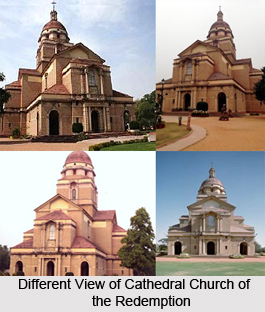 Cathedral Church of the Redemption also known as Viceroy Church is a famous church located in Delhi. It is located to the east of Parliament House in New Delhi and Rashtrapati Bhavan that was earlier used by then British Viceroy. The church was opened for public worship on Sunday, 18 January 1931. Cathedral Church of the Redemption has been built on Henry Alexander Medd`s design. The centralized plan of the church blends with Sir Edwin Lutyens`s city plan. The Cathedral Church of the Redemption India is a part of the Delhi diocese of the Church of North India.
Cathedral Church of the Redemption also known as Viceroy Church is a famous church located in Delhi. It is located to the east of Parliament House in New Delhi and Rashtrapati Bhavan that was earlier used by then British Viceroy. The church was opened for public worship on Sunday, 18 January 1931. Cathedral Church of the Redemption has been built on Henry Alexander Medd`s design. The centralized plan of the church blends with Sir Edwin Lutyens`s city plan. The Cathedral Church of the Redemption India is a part of the Delhi diocese of the Church of North India.
History of Cathedral Church of the Redemption
According to the history Cathedral Church of the Redemption was built between the years 1927 to 1935. The origin of the church can be traced back to the early decades of the 1900s. During this time Rev T.R. Dixon was appointed as the Chaplain to fulfil the spiritual needs of the British officers residing in the capital. During its construction many people came forward for donations. They were mostly royalty, viceroys, Christians and people of other faiths.
In 1925 the Chief Engineer was asked to prepare the plans for a 300 seater church. Many designs were placed among which H.A.N. Medd`s design was chosen. On 11 November 1925, he was asked to prepare the plans for the new Church. The foundation stone was laid on 23 February 1927 by Viceroy Irwin. The Cathedral Church of the Redemption was finally opened to public worship on Sunday, 18 January 1931. On 15 February 1931 church was consecrated by the Bishop of Lahore, assisted by the Chaplain of Delhi Rev. Storrs Fox and Rev. P. Dass.
Architecture of Cathedral Church of the Redemption
The Cathedral Church of the Redemption has been magnificently designed by the famous designer named Henry Medd. The church resembles the shape of a Birthday cake with a candle placed on top. The Church derives its name from Palladio`s Church of Il Redentore in Veniceas well as Lutyens St Jude`s Church, Hampstead Garden Suburb. The domes and high curved arches have been beautifully carved and adorn the beauty of the temple. Lord Irwin, the then Viceroy was so impressed by the beauty of the church that he named it as Viceroy Church. The exterior of this church is quite simple and beautiful while its interior has been brilliantly designed.
This church also has a very huge hall that can accommodate about 1000 to 2000 people. The beautiful altar of the church further adds to its beauty. The church is embellished with tinted glass windows. People visiting the church light candles and meditate here.
The two main festivals celebrated in the Cathedral Church of the Redemption are the Easter day and Christmas. These festivals are celebrated with great pomp and show and the church is also decorated beautifully. People come to this church early in morning for their special masses that is conducted on these two days. Various other social and cultural programmes are organised on these days.
The Cathedral Church of the Redemption is engaged in serving the society through its contributions in the field of education and health. Some of the prestigious institutions under the diocese of the church are St. Stephen`s College, St. Thomas School, Queen Mary`s School, The Victoria School, St. Stephen`s Hospital and the LPCEF.



















